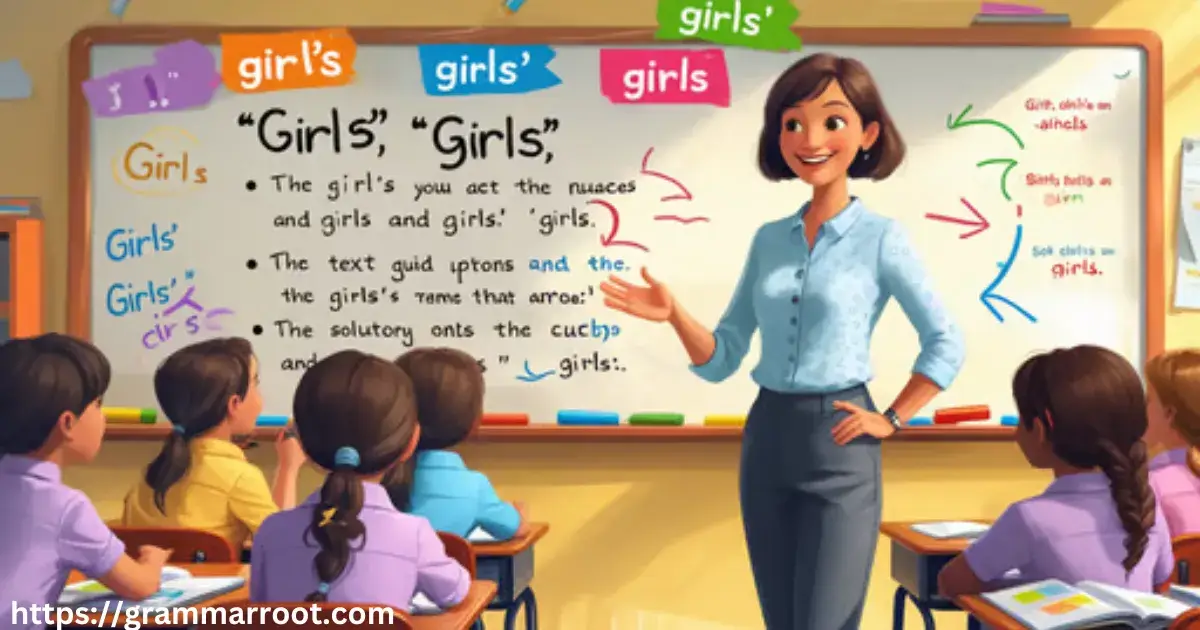The English language can be tricky when it comes to using apostrophes, especially when it comes to plural and possessive forms. Many people often confuse “girl’s,” “girls’,” and “girls” in their writing. In this article, we’ll break down the differences and give you clear, easy-to-follow examples to ensure you understand when to use each form. Let’s dive into this simplified guide!
1. “Girl’s” – Possessive Singular Form
When you see “girl’s,” the apostrophe comes before the “s,” indicating possession by one girl. This means something belongs to a single girl.
Example Scenario:
Imagine you’re writing an email about a specific girl’s new book. You could say:
Subject: A Special Gift for Lily
Hi Sarah,
I just wanted to let you know that Lily’s book arrived today! She’s so excited to share it with you. The cover is beautiful, and I know you’ll love it!
Best,
Emily
Here, Lily’s shows that the book belongs to Lily, which is one girl.
2. “Girls’” – Possessive Plural Form
When you use “girls’,” the apostrophe comes after the “s,” indicating possession by multiple girls. This is used to show that something belongs to more than one girl.
Example Scenario:
You might write an email about an event planned by a group of girls. In this case, you’d say:
Subject: The Girls’ Night Out Plan
Hi Amy,
I wanted to remind you about the girls’ night out this Friday. We’re meeting at 7 PM at the new restaurant downtown. It’s going to be a fun evening with lots of laughs and good food!
See you there!
Kaitlyn
Here, girls’ shows that the night out is planned by multiple girls.
3. “Girls” – The Plural Form (No Possession)
The word “girls” without an apostrophe simply refers to more than one girl. It’s the plural form of the noun “girl.” It’s used when you’re talking about a group of girls, without indicating possession.
Example Scenario:
Imagine you’re telling your friend about a fun activity that involves a group of girls.
Subject: Fun Day at the Park
Hi Rachel,
I had such a great time with the girls at the park yesterday! We played frisbee, had a picnic, and even played some volleyball. It was such a blast. I think we should do it again next weekend!
Talk to you soon,
Jessica
In this case, girls simply refers to more than one girl without implying possession of anything.
4. “Girl’s” vs “Girls”
When deciding between “girl’s” and “girls,” the key difference is whether you’re using a singular possessive or referring to a plural noun.
Example:
- Girl’s book – The book belongs to one girl.
- Girls play basketball – A group of girls is playing basketball.
5. “Girls’ Meaning with Apostrophe”
The apostrophe in “girls’” indicates possession by more than one girl. It’s important to place the apostrophe after the “s” when you’re talking about something belonging to a group.
Example:
- The girls’ project – The project belongs to a group of girls.
6. Girl Plural Form
The plural form of “girl” is simply “girls.” This is used when you’re talking about more than one girl, no possession involved.
Example:
- There are three girls in the competition.
7. “Girls’ or Girl’s Weekend”
A common mistake people make is whether to say “girls’ weekend” or “girl’s weekend.” The correct form depends on whether you’re referring to a weekend for one girl or a group of girls.
Example:
- Girls’ weekend – A weekend getaway for multiple girls.
- Girl’s weekend – A weekend getaway for one girl.
8. “Girls vs Girl” Relationship
When you compare “girls” and “girl,” the first refers to more than one girl, while the second refers to just one.
Example:
- Girls tend to be more chatty than girl.
- Girl often has a more personal and intimate experience than girls.
9. “Girls vs Boys” – A Classic Comparison
In many cases, people compare girls and boys in terms of interests, behavior, or activities. This doesn’t involve possession but highlights the difference between genders.
Example:
- Girls prefer shopping, while boys prefer playing sports.
10. “Girls vs Girls Pranks”
This comparison can be fun when you talk about pranks played by girls. When using “girls” here, you’re talking about a group of girls playing pranks.
Example:
- Girls’ pranks often involve playful jokes, but girls enjoy different kinds of pranks depending on their personalities.
11. Girls vs Girls Funny
When talking about girls vs girls in terms of humor, you may refer to funny situations where girls compete or share jokes.
Example:
- The competition was filled with girls’ funny moments from start to finish.
12. Girls vs Girls YouTube
Many YouTube channels feature challenges and content focused on girls vs girls situations.
Example:
- Girls challenge each other in cooking contests on YouTube.
13. Girls vs Girls Movie
In movies, the phrase “girls vs girls” is often used to describe the rivalry or friendships between groups of girls.
Example:
- Girls’ rivalry played out in the movie “Mean Girls,” a classic example of the drama between groups of girls.
14. Girls’ Day or Girl’s Day
The use of “girls’ day” or “girl’s day” depends on whether you’re referring to a single girl or a group of girls.
Example:
- Girls’ day out is a day for a group of girls to bond.
- Girl’s day is a special day for one girl, often for relaxation or celebration.
15. “Girl vs Girl” Relationship
This can refer to the comparison or rivalry between two girls in a relationship.
Example:
- There was tension between girl and girl in the relationship due to misunderstandings.
16. Girls’ Weekend Example
Imagine a scenario where multiple girls plan a weekend getaway. You would say:
Subject: A Fun Weekend Getaway
Hey Emma,
I can’t wait for our girls’ weekend! We’re going to have so much fun at the beach. We should try out some new activities and relax by the pool.
See you Friday!
Jessica
Here, girls’ refers to a group of girls going on a trip together.
17. Girls vs Boys: A Friendly Rivalry
Sometimes, the comparison of girls vs boys comes up in sports, school, or games, highlighting differences between the two genders in certain situations.
Example:
- Girls vs boys in the soccer match resulted in a thrilling tie!
18. Girls’ Birthday Party or Girl’s Birthday Party?
If you’re planning a birthday party for multiple girls, you would say “girls’ birthday party.”
Example:
- It’s going to be the girls’ birthday party next weekend.
19. Girls vs Girls’ Fashion
When discussing fashion trends for groups of girls, you might compare their styles or the fashion choices of different girls.
Example:
- The girls’ fashion trends are always changing, with new ideas popping up every season.
20. Girls’ Education or Girl’s Education
Lastly, you might want to distinguish between a single girl’s education and the collective education of many girls.
Example:
- Girls’ education has become a global focus in many countries to ensure equality in learning.
Conclusion
Understanding the correct use of “girl’s,” “girls’,” and “girls” can significantly improve your writing and help avoid common mistakes. Remember:
- Use “girl’s” for something belonging to one girl.
- Use “girls’” for something belonging to multiple girls.
- Use “girls” when simply referring to more than one girl without possession.
By mastering these distinctions, you can ensure your writing is not only grammatically correct but also clear and concise. Happy writing!

Johan is an professional & experienced blogger passionate about language and writing on Grammar root. He shares his expertise in grammar, punctuation, and effective communication, making complex rules simple and accessible for readers. With a knack for clear explanations and engaging content, Steel aims to help others master the art of language.

